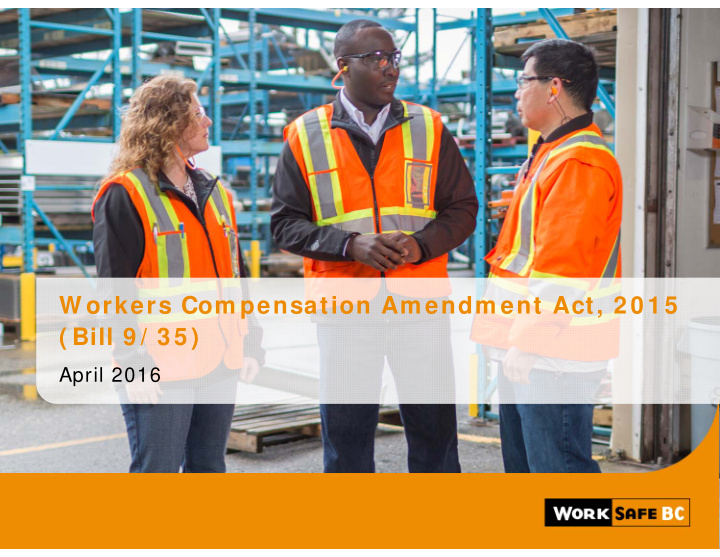



W orkers Com pensation Am endm ent Act, 2 0 1 5 ( Bill 9 / 3 5 ) April 2016 1
Workers Compensation Amendment Act , 2015 History • July 1, 2014: WorkSafeBC Review and Action Plan by Gordon Macatee • May 14, 2015: Bill 9 passed by Royal Assent making changes to the Workers Compensation Act • Effective September 15, 2015: Additional provisions of Bill 9 bought into force by Order-in-Council • Effective January 1, 2016: Workers Compensation Amendment Act, No. 2, 2015 (Bill 35) comes into effect and impacts employer incident investigations • In 2016: Implement further changes to the Act with Bill 35 and OHS Citations 2
Changes effective May 14, 2015 • Expanded stop work order powers • Changes to employer incident investigations • Expanded injunction powers • Changes to penalty due diligence 3
Changes effective September 15, 2015 • Compliance agreements • New 45-day timeline to request a review of Prevention orders • Two new members on WorkSafeBC’s Board of Directors • Employer OHS Citations - to be implemented in February 2016 4
Em ployer I ncident I nvestigations
Employer Incident Investigations Three major legislative changes: 1. Two phases of incident investigation, instead of one 2. Specific timelines for investigation completion, where previously there were none: • 48 hours for preliminary investigation • 30 days for full investigation 3. Investigation reports must be prepared in accordance with policies of WorkSafeBC’s Board of Directors, not the Occupational Health and Safety Regulation 6
Employer Incident Investigations Preliminary incident investigation policy Employers must: • Immediately undertake a preliminary investigation into an incident • Identify any unsafe conditions, acts, or procedures that significantly contributed to the incident • Identify what interim corrective action they plan to take between the date of incident and date the full investigation report is due (within 30 days of the incident) • Take all actions reasonably necessary, during the interim period, to prevent a recurrence of the incident 7
Employer Incident Investigations Preliminary Incident Investigation Policy (continued) Employers must: • Prepare a report of their preliminary investigations within 48 hours of the incident • Effective Jan. 1, 2016: Provide WorkSafeBC a copy of the report upon request and, as soon as practicable, give a copy to the joint committee or worker representative or, if neither exist, post in the workplace (latter was previously voluntary) • Prepare a report, if they take interim corrective action, that includes: • unsafe conditions, acts, or procedures that resulted in the corrective action • interim corrective action taken • date the corrective action was completed • Provide the corrective action report to the joint committee, worker representative, or if neither exist, post in the workplace 8
Employer Incident Investigations Full Incident Investigation Policy Employers must: • Undertake a full investigation immediately following completion of the preliminary investigation • Determine the cause or causes, and identify unsafe conditions, acts, or procedures that significantly contributed to the incident • Effective Jan. 1, 2016: Submit their full investigation report to WorkSafeBC and the joint committee, worker representative, or if neither exist, post it at the workplace, within 30 days of the incident (latter was previously voluntary) Note: extensions may be granted where the employer can demonstrate that delays are due to factors outside their control 9
Employer Incident Investigations Full Incident Investigation Policy (continued) Employers must: • Provide a copy of the report that outlines their corrective action to the joint committee, worker health and safety representative, or post it at the workplace • The report must include: • unsafe conditions, acts, or procedures that made the corrective action necessary • corrective action taken to prevent recurrence of similar incidents • names and job titles of those responsible for implementing the corrective action • date the corrective action was taken 10
W hat’s next?
Employer OHS Citations Expected to be implemented February 2016: • Proposed New Low er Maxim um Adm inistrative Penalties Regulation (LMAPR) and associated policy • OHS Citations will be imposed only for non-compliance with orders, or requirements for compliance reports • Not available for orders arising out of high risk violations • Employers will always receive a written warning before being issued an OHS Citation • A first OHS Citation will be $500 (half the maximum) • Any further OHS Citations issued within three years will be $1,000 (the maximum) • Amounts adjusted annually pursuant to consumer price index 12
Bill 35 Effective January 1, 2016: • Immediate reporting of all workplace fires or explosions with the potential to cause serious injury to a worker • Increased role for workplace health and safety committees and worker OHS representatives including: • Employer provision of preliminary and full incident investigation reports • Meaningful participation in employer incident investigations • Advising employers about significant proposed equipment and machinery changes that may affect worker health and safety • WorkSafeBC to proactively assist workplace health and safety committees in resolving OHS-related disagreements 13
Questions?
Recommend
More recommend